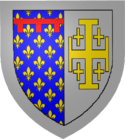Charles, Duke of Calabria


Charles, Duke of Calabria (1298 – 9 November 1328) was the son of King Robert of Naples and Yolanda of Aragon.
Biography
Charles was born in Naples in 1298, during the reign of his grandfather King Charles II, the son of Prince Robert and Yolanda of Aragon. Little is known of his early life, so one can assume that he spent his early years at the court of his grandfather. In 1309, when Charles was 11 years old, his 56-year-old grandfather died and his father became King Robert the Wise. It was then that he became Duke of Calabria and was created Vicar-General of the Kingdom of Sicily (Naples). His father intended him to lead the force sent to aid Florence in 1315, but was constrained by time to send Robert's brother, Philip I of Taranto, instead. The Florentine-Neapolitan coalition was badly beaten at the ensuing Battle of Montecatini.
The victory of Castruccio Castracani at Altopascio in 1325 led the Florentines to elect Charles signore (lord) of the city for ten years in 1326. At the time, he was unsuccessfully attempting to seize Sicily from his first cousin Frederick III, and sent Walter VI of Brienne as his deputy until he could arrive, where Walter made a (misleadingly) favorable impression. While Charles' arrival checked Castruccio, he exacted onerous taxes from the Florentines, until he was recalled to Naples in December 1327 due to the advance of Emperor Louis IV into Italy. There he died in 1328. He left as heir his eldest surviving daughter, Joanna Ι; a posthumous daughter, Marie, was born in 1329.
Charles was buried in the church of Santa Chiara in Naples.
Family and ancestry
In 1316, he married Catherine of Habsburg (1295–1323), daughter of Albert I of Germany. After her death, he married Marie of Valois (1309–1332), daughter of Charles of Valois. They had five children:
- Eloisa (b. January or February 1325 - d. 27 December 1325).
- Joanna Ι (b. Naples, March 1326 – d. castello di San Fele, 22 May 1382), Queen of Naples after succeeded her grandfather.
- Charles Martel (b. Florence, 13 April 1327 – d. Florence, 21 April 1327).
- Maria (b. posthumously, Naples, May 1329 – d. Naples, 20 May 1366), Countess of Alba.
External links
- Cawley, Charles, Medieval Lands Project, Medieval Lands database, Foundation for Medieval Genealogy,
- History of Florence, Niccolò Machiavelli